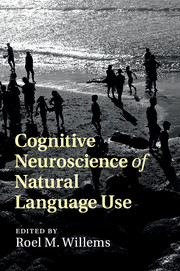Book contents
- Cognitive Neuroscience of Natural Language Use
- Cognitive Neuroscience of Natural Language Use
- Copyright page
- Contents
- Plates
- Figures
- Contributors
- Abbreviations
- 1 Cognitive neuroscience of natural language use: introduction
- 2 fMRI methods for studying the neurobiology of language under naturalistic conditions
- 3 Why study connected speech production?
- 4 Situation models in naturalistic comprehension
- 5 Language comprehension in rich non-linguistic contexts: combining eye-tracking and event-related brain potentials
- 6 The NOLB model: a model of the natural organization of language and the brain
- 7 Towards a neurocognitive poetics model of literary reading
- 8 Putting Broca’s region into context: fMRI evidence for a role in predictive language processing
- 9 Towards a multi-brain perspective on communication in dialogue
- 10 On the generation of shared symbols
- 11 What are naturalistic comprehension paradigms teaching us about language?
- Index
3 - Why study connected speech production?
Published online by Cambridge University Press: 05 February 2015
- Cognitive Neuroscience of Natural Language Use
- Cognitive Neuroscience of Natural Language Use
- Copyright page
- Contents
- Plates
- Figures
- Contributors
- Abbreviations
- 1 Cognitive neuroscience of natural language use: introduction
- 2 fMRI methods for studying the neurobiology of language under naturalistic conditions
- 3 Why study connected speech production?
- 4 Situation models in naturalistic comprehension
- 5 Language comprehension in rich non-linguistic contexts: combining eye-tracking and event-related brain potentials
- 6 The NOLB model: a model of the natural organization of language and the brain
- 7 Towards a neurocognitive poetics model of literary reading
- 8 Putting Broca’s region into context: fMRI evidence for a role in predictive language processing
- 9 Towards a multi-brain perspective on communication in dialogue
- 10 On the generation of shared symbols
- 11 What are naturalistic comprehension paradigms teaching us about language?
- Index
Summary
The speech that is termed “natural speech” or “connected speech” – the speech that is spoken spontaneously and with minimal monitoring by the speaker – is the most systematic form of language production and the most representative of an individual’s linguistic capabilities. It stands in contrast to speech that is elicited one word at a time, with full attention focused on the production of the word, as in confrontation naming, verbal fluency, or repetition tasks. In our work, we elicit a lengthy body of continuous speech by asking subjects to tell a story from a children’s picture book. We examine the resulting speech in patients with a range of neurodegenerative diseases in an effort to differentiate among the conditions. In each case, the level of linguistic analysis is based on hypotheses about the effects on language production of the different forms of neuropathology. We also relate performance on linguistic variables to gray matter atrophy and reduced fractional anisotropy in white matter in order to illuminate the neuroanatomic substrates of natural language production. In this chapter, we discuss analyses of connected speech production with respect to speech rate, speech errors and apraxia of speech, lexicon, grammar, and discourse structure in individuals with primary progressive aphasia, frontotemporal degeneration, Alzheimer’s disease, and variants of Parkinson’s disease.
- Type
- Chapter
- Information
- Cognitive Neuroscience of Natural Language Use , pp. 29 - 58Publisher: Cambridge University PressPrint publication year: 2015
- 17
- Cited by

